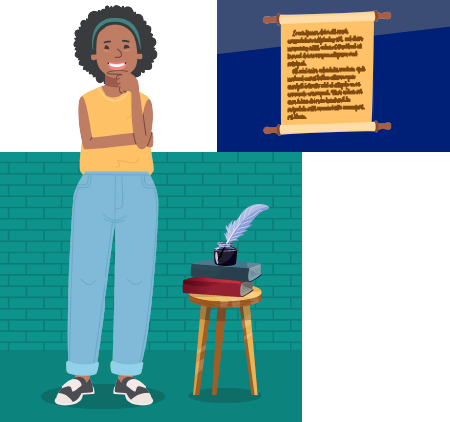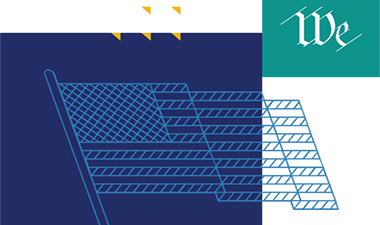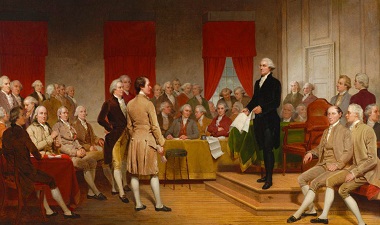
Getting Started
This module includes an Unboxing the Constitution video (4 min), two Inside the Constitution videos (5 min and 2 min), student activities, and a learning project. Download the Teachers Guide and the Student Content Guide for more details on content and implementation. Course materials are provided in Google documents, Word documents, as well as printable PDFs.
A preview of the module can be accessed below.
Topics covered include:
- Enlightenment influences on the Declaration
- Text of the Declaration
- List of Grievances

Vocabulary
At the beginning of each module, students are presented with vocabulary words and definitions.
Concept Words
Concept words are conceptually related to the big ideas in what they’re learning. These connect directly to the core concepts or themes of the lesson or unit and help students grasp the main ideas and how everything fits together.
- natural rights: rights that are given by God or by nature and are fundamental to all humans
- popular sovereignty: the Constitution establishes a government based on the agreement of the people being governed; sovereign power is held by the American people
- revolution: overthrowing a government to create a new system
- social contract: the idea that people grant the government limited powers and control over some rights; in return, the government has a responsibility to provide safety and security to its people
Speed Bump Words
Speed bump words are words that aren’t central to the concept being taught, but if students don’t understand them, they may struggle to comprehend the text or lesson. These words can help shape students' overall understanding of the topic.
- assembly: gathering together as a group for a common purpose
- constitutionalism: the idea of a government with limited powers that are defined in advance
- grievance: a complaint over something
- Parliament: the legislature (lawmakers) in Great Britain
- representation: one that stands in for another (for example; an elected official in the legislature represents the people who elected her)
- rule of law: the idea that we have a government of laws, not an arbitrary government of one person. In other words, no one is above the law
- tax: a way the government collects money from citizens

Topic 1: Key Principles of the Declaration of Independence and the Colonial Government
Revolution is on the way as the British increase pressure on the colonists and try to assert control. People are increasingly dissatisfied with British rule and the abuses that come with it. And as this pressure increases, it’s becoming increasingly clear that the solution is a new government. This new government would be built upon the key principles, or ideas, that form the basis of American democracy. These key principles didn’t just occur to the founders. In fact, thinking, talking, and writing about these and other ideas goes back centuries. Use this module to explore these questions and more, and discuss how these principles connect to both the revolutionary time period and today.
2.1: Activate Prior Knowledge
Students will complete a KWL chart to identify what they know and what they want to know about the American Revolution.
Unboxing the Constitution
In this Unboxing the Constitution video, Lucy explores the influences of and big ideas behind the American Revolution.
2.2: Great Thinking
What are the big ideas that shaped the Revolution? Where did they come from? Who thought of them and shared them? Students will use the video notes guide as they watch the Inside the Constitution videos to learn more about these big ideas and how they connected to early American history.
Inside the Constitution, Part I
Inside the Constitution, Part II
2.3: Great Thinkers
Students will explore primary sources from several key thinkers who shaped the Framers’ beliefs about America.
Review the Teacher Guide for this module for some implementation tips for these primary sources from history.
2.4: Declaring Independence
What does the Declaration of Independence actually say? Students will summarize it in their own words to deepen understanding about this founding document.
2.5: Closing Activity
Students will check in on the Key Question(s).

Topic 2: British Imperial Reform and the American Revolution
The desire to build a new government based on these principles is what led the United States to officially declare independence from the British on July 4, 1776. The Declaration of Independence was written primarily by Thomas Jefferson, working with others as part of the Committee of Five (John Adams, Benjamin Franklin, Robert Livingston, and Roger Sherman). The Declaration made it clear that this new government was being formed in response to grievances or complaints against King George III and British rule shared by the colonists.
2.6: List of Grievances
Why did the colonists decide to declare independence? Students will explore the list of grievances from the Declaration of Independence for clues about the actions of the British monarch and the colonists’ frustrations.
2.7: The Colonists and the British People
What would you say to the British if you were a colonist before the Revolution? Looking to Common Sense for guidance, students will write a letter to the British with their thoughts and insights.
2.8: Civic Connection: Modern Day Grievances
In this Civic Connection activity, students will work to answer: What are some modern day grievances? How would they show their frustration about these grievances today?
2.9: Reflect
To end this module, students will revisit the KWL handout and key questions from the beginning of the module to see how insights have grown throughout the lesson.

Learning Project: Enlightenment 2.0: Modern Media for Classical Thinkers
In this activity, students will have the opportunity to consider how Enlightenment thinkers might have used social media to talk about their views and to engage in conversation about the views of others and will create a plan to use modern methods to clearly express their thoughts, views, and opinions.













